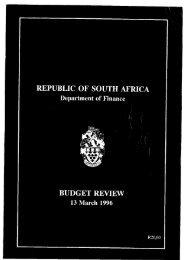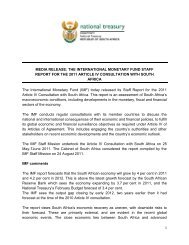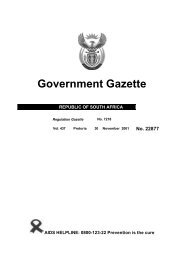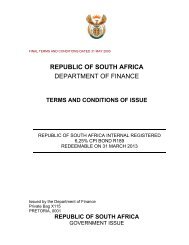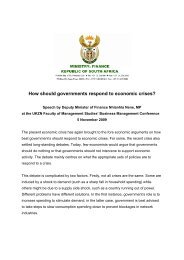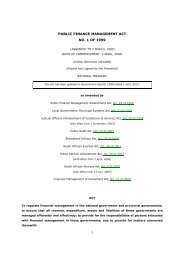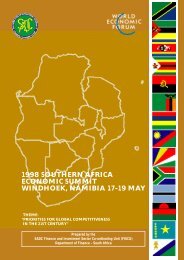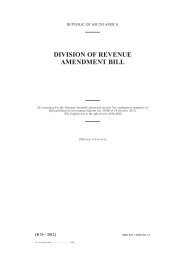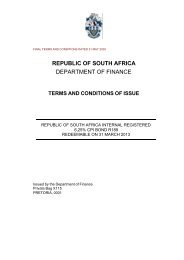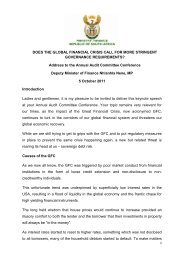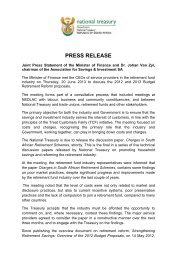1995 - National Treasury
1995 - National Treasury
1995 - National Treasury
Create successful ePaper yourself
Turn your PDF publications into a flip-book with our unique Google optimized e-Paper software.
-IX-<br />
« proposed changes to taxes (if any); and<br />
the Budget Review<br />
The Printed Estimate of Expenditure (RP 2,<br />
First Print), commonly called the "White Book",<br />
contains the planned expenditure for which the<br />
national government takes responsibility, i.e.<br />
expenditure by national government spending<br />
agencies. Also included are transfer payments to<br />
be made from the national budget to other levels<br />
of general government, such as provincial and<br />
local governments. Printing of the "White Book"<br />
starts about two months before the Budget is<br />
tabled in Parliament.<br />
When the Budget is tabled in Parliament, the<br />
Minister of Finance may announce supplementary<br />
expenditure proposals, which are to be included in<br />
the Supplementary Estimate of Expenditure<br />
(RP 4) some time after the Budget, when it is<br />
approved by Parliament. In the past, supplementary<br />
expenditure proposals included, among<br />
others, expenditure that could not be included<br />
timeously and/or expenditure that could not be<br />
allocated to a specific spending agency in the<br />
"White Book".<br />
The Printed Estimate of Expenditure (RP 2 and<br />
4, Second and Final Print), commonly called the<br />
"Blue Book", comprises the expenditure contained<br />
in both the "White Book" and the Supplementary<br />
Estimate of Expenditure. At the time of the<br />
Budget, the Minister of Finance can also identify<br />
estimates of certain expenditure that may arise<br />
during the financial year, but due to lack of detail,<br />
could not be allocated to a specific spending<br />
agency in the "White Book" or "Blue Book".<br />
These are included in the Adjustments Estimate<br />
towards the end of the financial year.<br />
Thus, at the time of the Budget, the Minister of<br />
Finance gives a total estimate of the expenditure<br />
level for the new financial year, which<br />
constitutes the sum of expenditure contained in<br />
the "White Book", supplementary expenditure<br />
proposals (if any) and other expenditure that will<br />
be included in the Adjustments Estimate (if any).<br />
When the Budget is tabled in Parliament, projections<br />
of total revenue (i.e. taxes and non-tax<br />
revenue) to be collected by the national government<br />
in that specific financial year are contained<br />
in the Printed Estimate of Revenue (RP 3, First<br />
Print). The First Print enables policy makers to<br />
ascertain the level of revenue for a specific year<br />
if no changes are made to the tax structures and<br />
rates of the previous fiscal year. The Minister of<br />
Finance may then announce, for specified<br />
reasons, tax proposals, which are proposed<br />
changes to the existing tax bases, rates and/or<br />
brackets, or may include the introduction of new<br />
taxes. Total estimated revenue for the new<br />
financial year is, therefore, the projected collections<br />
after the tax proposals have been taken into<br />
account and is included in the Printed Estimate<br />
of Revenue (RP 3, Second and Final Print).<br />
The Budget Review summarises and puts in<br />
perspective the proposed expenditure and<br />
revenue of national government for the coming<br />
year, against the background of an overview of<br />
the country's economic circumstances and prospects,<br />
the outcome of the previous year's budget,<br />
important trends and developments in the field of<br />
public finance and the broad approach which<br />
government intends following to ensure sound<br />
fiscal management and in pursuit of particular<br />
policy goals.<br />
To present as comprehensive as possible a<br />
picture on government expenditure when the<br />
national budget is tabled in Parliament 8 , a consolidation<br />
between the national budget and the<br />
Since more than 60 per cent of total expenditure<br />
on the national budget are transfer payments to<br />
other levels of general government, economic and<br />
functional classifications of national budget expenditure<br />
do not present an overall picture. For purposes of<br />
analysis, the ideal is, of course, to present economic<br />
and functional classifications of the general government<br />
(i.e. first, second and third level of government)<br />
expenditure. This requires information on the expenditure<br />
at all levels of general government and on the<br />
financing thereof by way of revenue, balances brought<br />
forward and transfer payments (mainly from the national<br />
budget). This information is not readily and timeously<br />
available - especially at the third level of general<br />
government - which makes it impossible to present<br />
consolidated general government finances when the<br />
national budget is tabled in Parliament. The South<br />
African Reserve Bank does, however, publish historical<br />
data on general government finances in its Quarterly<br />
Bulletin.



